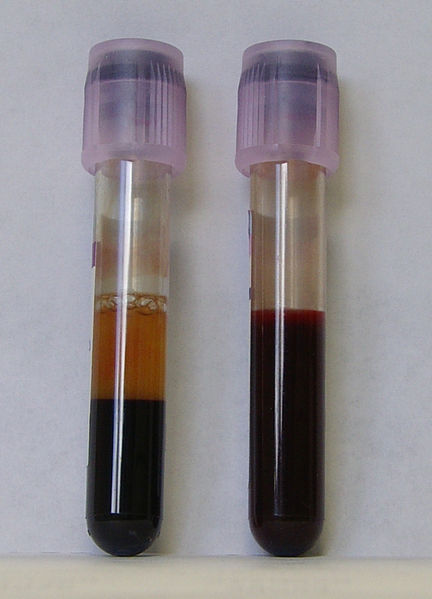
Blood contains plasma and blood cells, some of which have hemoglobin that makes blood red. The average blood volume in adult is five liters.
Blood is a specialized bodily fluid in animals that delivers necessary substances, such as nutrients and oxygen, to the cells and transports metabolic waste products away from those same cells. Blood plays many roles in sustaining life and has physical characteristics that distinguish it from other body tissues.
Blood is a fluid that is technically considered a connective tissue. It is an extracellular matrix in which blood cells are suspended in plasma. It normally has a pH of about 7.4 and is slightly denser and more viscous than water. Blood contains red blood cells (RBCs), white blood cells (WBCs), platelets, and other cell fragments, molecules, and debris. Albumin is the main protein found in plasma, and it functions to regulate the colloidal osmotic pressure of blood.
Blood appears red because of the high amount of hemoglobin, a molecule found on RBCs. Each hemoglobin molecule has four heme groups that interact with various molecules, which alters the exact color. In oxygenated blood found in arterial circulation, hemoglobin-bound oxygen creates a distinctive red color.
Deoxygenated blood is a darker shade of red. It is present in veins and can be seen during blood donation or lab tests. Carbon monoxide poisoning causes bright red blood due to the formation of carboxyhemoglobin. In cyanide poisoning, venous blood remains oxygenated, increasing the redness. Under normal conditions, blood can never truly be blue, although most visible veins appear blue because only blue light can can penetrate deeply enough to illuminate veins beneath the skin.
Blood generally accounts for 8% of the human body weight. The average adult has a blood volume of roughly five liters (1.3 gal). By volume, red blood cells constitute about 45% of whole blood, plasma about 54.3%, and white cells about 0.7%, with platelets making up less than 1%.

Composition of blood: Two tubes of EDTA-anticoagulated blood. Left tube: After standing, the RBCs have settled at the bottom of the tube. Right tube: contains freshly drawn blood.
Blood volume is a regulated variable that is directly proportional to blood pressure through the output of the heart. In order to maintain homeostasis, blood volume and blood pressure must be high enough that blood can reach all of the body’s tissues, a process called tissue perfusion. Most tissues can survive without perfusion for a short amount of time, but the brain needs a continuous supply of oxygen and glucose to stay alive.
Many mechanisms exist to regulate blood volume and tissue perfusion, including renal water excretion in the kidney, the pumping activity of the heart, and the abilities of the arteries to constrict or dilate. When blood volume becomes too low, such as from an injury, dehydration, or internal bleeding, the body will enter into a state of hypovolemic shock, in which tissue perfusion decreases too much. A healthy adult can lose almost 20% of blood volume (1 L) before the first symptom, restlessness, begins, and 40% of volume (2 L) before hypovolemic shock sets in. Conversely, higher than normal blood volume may cause hypertension, heart failure, and aneurysms.
16.1B: Physical Characteristics and Volume is shared under a CC BY-SA license and was authored, remixed, and/or curated by LibreTexts.